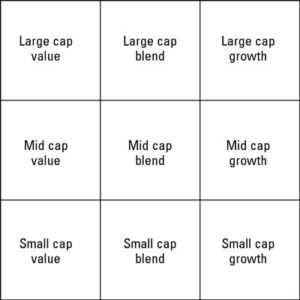The Wall Street Journal on October 26, 2017, published a front-page story about Morningstar, the mutual fund ratings firm. Morningstar is famous for its star ratings. Five star is the best, and one star is the lowest. Morningstar also has a grid – for stock mutual funds, the grid axes are market cap and income or growth. Here is an example of the grid for stock funds:

The Journal article was more concerned with the star ratings. The Journal went back and looked at Morningstar’s star ratings and then researched the performance of the funds subsequent to their ratings. The Journal found that fewer than 15% of funds that got the coveted 5-star rating was able to maintain that rating a couple of years later. Smaller funds, in particular, were very volatile in their star-ratings. Here is the scenario:
- Small fund starts up and does well for the first few years, for whatever reason.
- As a result, they receive a 5-star rating. Money managers and investors pick up on this new hot fund and send money their way.
- The fund’s AUM grows quickly.
- However, due to the new money, or due to changing market conditions, the fund managers aren’t able to invest the new, larger fund the same way they had on the way up.
- Performance suffers.
- Morningstar downgrades the fund from 5 stars down to something lower.
- Investors flee the fund.
It’s a sad story, but one that has played out many times before: Investors chase returns, but the world changes and they lose money. It happens in sports pretty often: Manager or coach does well with a young team, the team overachieves and maybe does well in the playoffs or even wins a championship. Coach is rewarded with a contract extension. However, maybe due to injuries or better competition, the team underperforms the next couple of years. All of a sudden, the coach is no good and he gets canned.
Over-Reliance
The problem here is not Morningstar. They are just a rating agency. The problem is that money managers and investors have over-relied on Morningstar and have not done their own due diligence on the fund and its managers. Morningstar’s star system was meant to be one piece of the decision to invest in a certain fund – not the entire decision, as it has been too often. The Journal article illustrated how some money managers point out with pride that they only put their clients into 5-star funds.
CYA
Why do some managers do this? To provide cover for if and when they get sued. If they put a client into a 5-star fund and it loses money, the manager can fall back on the Morningstar rating to say they weren’t negligent. If instead, the manager puts the client into a 3-star fund and it loses money, the CYA argument is weaker. Another example of the overly-litigious society we have, and the pressure that money managers are under when they stand to lose more than a client’s money if an investment under-performs.
Only Morningstar
The Journal article addresses the above issues (it was a lengthy article). One issue that the article didn’t address is that Morningstar holds too dominant of a position in the mutual fund ratings business. There are others out there, but no other firm’s ratings hold the sway that Morningstar’s do. For other sectors wherein ratings are important – debt issuance and insurance companies, for example – there are Standard & Poor, Moody’s, Fitch, and AM Best. An investor or manager can choose among these rating agencies and make up their own mind. With mutual funds, it seems they look only to Morningstar. This is not a criticism of Morningstar. It is a criticism of those that have put all of their eggs in the Morningstar basket.
IMO
There is no substitute for doing your own research and making up your own mind about your own investments. Morningstar is a great tool, and certainly factor the Morningstar star rating as part of your decision, but also look at the manager’s strategy and how that fits with your investment objectives. Look at the fund’s top holdings and see what you think about them. Determine if you are comfortable with a new fund with a high Morningstar rating even though the fund is new and hasn’t gone through multiple market conditions. Maybe you are instead more comfortable with an older fund that might have a lower rating but that fits with your objectives and has been through the wars. Use other ratings services – Value Line rates funds, and you can access it for free through your library’s website. Understand what the Morningstar ratings mean and what they are supposed to be used for before making an important financial decision.
